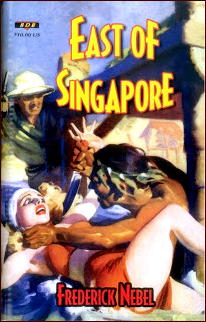Sat 9 Feb 2013
Pulp Fiction Review: FREDERICK NEBEL – East of Singapore.
Posted by Steve under Pulp Fiction , Reviews[6] Comments
FREDERICK NEBEL – East of Singapore. Black Dog Books, chapbook, 2004. First published in Action Stories, July 1926, under the title “Somewhere East of Singapore.â€

Back before Tom Roberts and his associates at Black Dog Books were publishing their current array of perfect-bound paperbacks – all of which if you are a pulp fiction fan of all forms and varieties, I highly recommend to you – they produced a short series of tall saddle-stapled chapbooks, of which this is one.
I don’t know what the print run might have been for these early examples of their production art, but I imagine it was small. The number of pulp collectors who might have purchased this particular one, to pick a prime example, is not very large, and I suspect that those who did buy one have kept them. At any rate, when I checked yesterday, there was not a single copy being offered for sale on the Internet.
The original price was $10, and perhaps back in 2004, that was relatively steep for a 68 page paperback. Still, considering how long it would take you to find a copy of Action Stories from any month in 1926, and how much you’d probably have to fork over for it, the ten bucks outlay might seem OK after all.
And if you were to get your hands on one, what then? You may ask. A mixed bag, if you were to ask me. Nebel’s prose is clear and descriptive and often a joy too read. Picking the book open and choosing a passage (from page 5, taking place in the streets of Singapore):
And from page 28, as Jack Berk and his companion Marty Young, white men both, and young and daring, make their way through the Borneo jungle, searching for a treasure lode of buried jewels, on behalf of a beautiful girl:
That I mentioned that Berk and Young are white is important. The natives are “heathen rascals†(page 9) and from page 12: “A reckless disregard of odds has ever been the bright badge of those white men who have ventured among strange peoples and lifted the white man head and shoulders above his duskier brothers.â€
Please don’t forget that this was written in 1926. Fiction can often tell us more about ourselves than any history book ever could. The real flaw in this story is that it is all action, the outcome is foreordained from the beginning, and the final few chapters can be skimmed through with no fear of missing anything important. But if fast and furious jungle action is your wish, along with immersing yourself in the allure of the mysterious Far East, then this adventure caper has both, and in depth.
February 9th, 2013 at 10:09 am
For more adventure stories by Nebel, Black Dog Books has also recently published EMPIRE OF THE DEVIL, which reprints over 300 pages of pulp fiction. Also has a nice biographical introduction and a bibliography of his fiction. He wrote for a wide range of magazines including slick, pulp and digest.
February 9th, 2013 at 11:15 am
Quite coincidentally, Evan Lewis reviewed EAST OF SINGAPORE on his blog not too long ago, and he mentions EMPIRE OF THE DEVIL as well.
If I read him correctly, EAST OF SINGAPORE is one of the stories included in the later book.
http://davycrockettsalmanack.blogspot.com/2013/01/fridays-forgotten-books-links-plus-east.html
February 9th, 2013 at 2:25 pm
Off topic- how’s the weather in your corner of Minimundus ?
The news about the US East Coast sound alarming .
The Doc
February 9th, 2013 at 6:56 pm
What a mess, that’s all I can say. Two feet and few inches of snow here, and after a while you run out of places to put the stuff.
February 9th, 2013 at 7:29 pm
That’s quite a lot worse than we have it in the Alps .
Especially services like snowplows, electricity, phone, net, water,sewage, work perfectly.
The only thing that remains is the front yard and the way to the garage, and we have man coming for that .
If he can’t come, like the last couple days, the cleaning woman shovels the snow away .
And we certainly don’t have more than some inches a day, if it falls .
We are way below the mountains .
Has the East Coast climate always been so fierce in the winter ?
The Doc
February 11th, 2013 at 8:21 am
My cousin lives near you, Steve – on the other side of Hartford, I believe – and she said she had over 2 1/2 feet plus drifts (she’s at the top of a hill). Fortunately she still has power.
I’m glad we’re in Florida for a month.